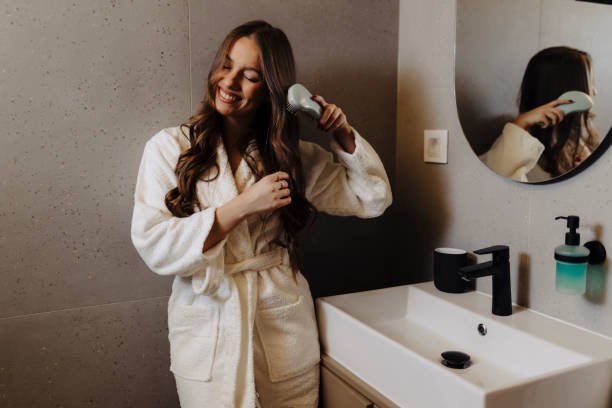Daily Hair Care Routine is crucial for keeping your hair healthy and looking its best. No matter if your hair is straight, wavy, curly, or coily, a tailored approach can help you reach your styling goals while promoting overall hair health. This guide will outline the essential steps and tips for crafting a personalized hair care regimen.
Understand Your Hair Type

The first step to an effective hair care routine is recognizing your hair type. Hair can be categorized by texture, density, porosity, and moisture levels. Here’s a breakdown:
- Texture: Hair can be straight, wavy, curly, or coily, and each type requires specific care methods.
- Density: This refers to the thickness of your hair. Thicker strands may need more product, while finer hair generally benefits from lighter formulations.
- Porosity: This measures how well your hair absorbs moisture. Low-porosity hair tends to resist moisture, while high-porosity hair absorbs it easily.
- Moisture Level: Identify whether your hair is dry, normal, or oily, as this will guide your product selection.
By understanding these factors, you can choose the most suitable products and techniques for your daily routine.
Key Steps for a Daily Hair Care Routine
1. Cleansing
Cleansing is essential for removing dirt, oils, and product buildup from your hair. How often you wash your hair depends on your hair type:
- Oily Hair: Wash daily or every other day.
- Normal Hair: Two to three times a week is usually sufficient.
- Dry or Curly Hair: Aim to wash once a week or as needed.
Choosing the Right Shampoo:
- If your hair is color-treated or dry, opt for sulfate-free shampoos to prevent further drying.
- For oily hair, a clarifying shampoo can help, but use it sparingly to maintain natural oils.
2. Conditioning
Conditioning is crucial for replenishing moisture and making your hair more manageable.
- Daily Conditioner: After each wash, apply a lightweight conditioner, focusing on the ends.
- Deep Conditioning: Incorporate a deep conditioning treatment once a week for extra hydration and repair.
Application Tips:
- Apply conditioner to the mid-lengths and ends of your hair, avoiding the roots to prevent greasiness.
- Allow the conditioner to sit for a few minutes before rinsing to maximize its effectiveness.
3. Moisturizing and Styling
After cleansing and conditioning, it’s time to moisturize and style your hair.
- Leave-in Conditioner: This product helps retain moisture and offers extra protection. Apply it to damp hair, concentrating on the ends.
- Styling Products: Select products tailored to your hair type and styling goals:
- Curl Creams: Enhance curls and minimize frizz.
- Serums: Add shine and tame flyaways.
- Gels or Mousses: Provide hold and volume.
4. Drying Techniques
The way you dry your hair can greatly influence its health and appearance.
- Air Drying: Whenever possible, let your hair air dry to reduce heat exposure.
- Towel Drying: Use a microfiber towel or a cotton T-shirt to gently blot away excess moisture; avoid rough towel-drying to prevent frizz.
- Heat Drying: If you need to use a blow dryer, apply a heat protectant spray and set it to a low or medium heat setting.
5. Night Care
Caring for your hair at night is just as important. Here are some practices to maintain its health:
- Silk or Satin Pillowcases: These materials create less friction than cotton, helping to reduce frizz and breakage.
- Loose Hairstyles: Choose loose braids or buns to minimize tangling while you sleep.
- Overnight Treatments: Consider applying a small amount of hair oil or leave-in conditioner before bed for added nourishment.
Additional Tips for Healthy Hair
1. Regular Trims
Schedule trims every 6-8 weeks to remove split ends and keep your hair looking fresh. Regular haircuts can prevent further damage and support healthy growth.
2. Avoid Over-Washing
Washing your hair too often can strip it of its natural oils, leading to dryness. Adjust your washing frequency according to your hair type and lifestyle.
3. Protect from Heat
Limit the use of heat styling tools like curling irons, flat irons, and blow dryers. When you do use them, always apply a heat protectant and choose the lowest effective temperature.
4. Stay Hydrated and Eat Well
Healthy hair begins from within. Drink plenty of water and maintain a balanced diet rich in vitamins and minerals, particularly those beneficial for hair health, such as biotin, vitamin E, and omega-3 fatty acids.
5. Limit Chemical Treatments
Frequent chemical processes, such as coloring, perming, or relaxing, can weaken your hair. If you choose to color your hair, consider gentler options or seek professional help for more intense treatments.
Adjusting Your Routine for Seasonal Changes
Your hair care routine may need adjustments as the seasons change:
- Summer: Use UV protection products to shield your hair from sun damage. Lighter formulations can help manage humidity without weighing your hair down.
- Winter: Combat dryness with richer conditioners and deep conditioning treatments. Be cautious with hot showers, as they can strip moisture from your hair.
Creating a Customized Routine

Once you’ve grasped the basics, you can personalize your routine to meet your specific hair needs. Keep track of what works and what doesn’t, and don’t hesitate to try new products or techniques.
Sample Daily Routine
Here’s a straightforward daily hair care routine to help you get started:
Morning:
- Apply leave-in conditioner to damp hair.
- Use a styling product suitable for your hair type.
- Air dry or blow dry on a low setting.
Night:
- Gently brush to remove tangles.
- Apply a small amount of hair oil or cream.
- Style your hair loosely for the night.
Conclusion
Establishing a daily hair care routine can be simple and manageable. By recognizing your hair type and adopting a clear regimen filled with healthy practices, you can attain the vibrant, healthy hair you’ve always wanted. Remember, consistency is essential; over time, you’ll see the positive results of your efforts. Embrace your hair journey and enjoy the process of finding what works best for you!

